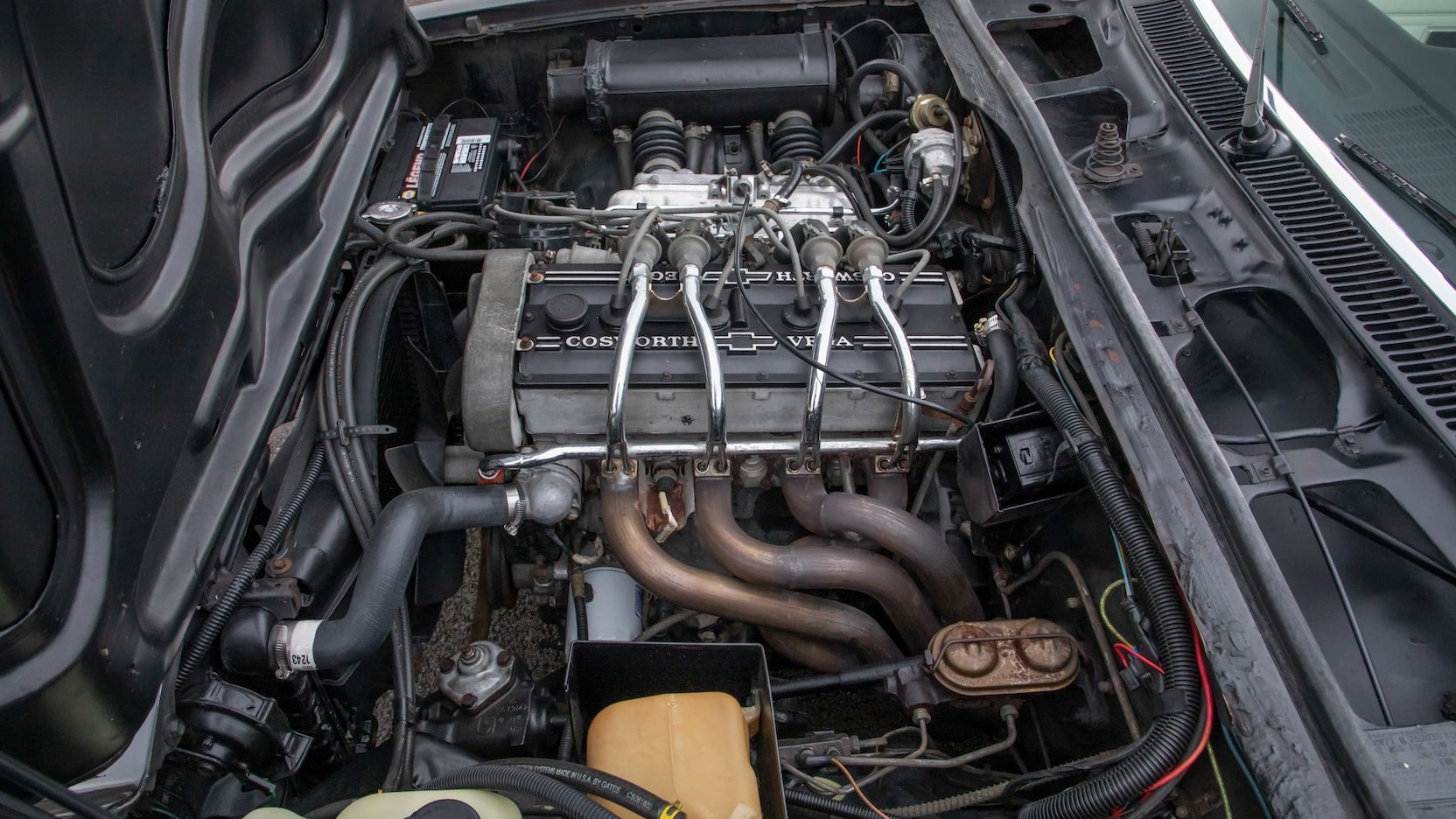The Chevrolet Cosworth Vega. Even the name itself conjures images of European performance blended with American muscle. Born from ambitious plans and brimming with technical innovation, this compact car promised to be an import-fighter, a true driver’s machine from General Motors. Dubbed the “CosVeg” by the media, it arrived with considerable hype, yet its journey was brief, spanning only the 1975 and 1976 model years. While it didn’t fully realize its potential, the Chevrolet Cosworth Vega remains a fascinating chapter in automotive history, a testament to ambition and a poignant reminder of unmet promises.
The Vega’s Foundation and the Cosworth Vision
Introduced in September 1970, the Chevrolet Vega was Chevy’s foray into the subcompact market. Available in a variety of body styles, including a two-door hatchback, notchback, wagon, and sedan delivery, the rear-wheel-drive Vega quickly garnered attention, even earning Motor Trend‘s prestigious 1971 “Car of the Year” award. However, beneath the initial accolades, the Vega faced challenges. It was within this context, four and a half years later, that the limited-production, high-performance Chevrolet Cosworth Vega emerged.
The genesis of the Cosworth Vega can be traced back to 1969. John DeLorean, then Chevrolet’s general manager, envisioned a potent 2.0-liter engine for racing championships on both sides of the Atlantic. He approached Cosworth Engineering, renowned Formula 1 engine suppliers, and convinced Keith Duckworth to develop an all-out racing version of the Vega’s aluminum-block four-cylinder engine. By March 1971, a prototype engine roared to life on the dyno, demonstrating an impressive 290 horsepower. However, this racing engine proved to be unreliable, and the racing program was eventually shelved.
Despite the racing project’s demise, the idea of a high-performance Vega persisted. Vega sales were lagging, and while the GT model offered sporty aesthetics, it lacked the performance to truly excite buyers. DeLorean and his assistant chief engineer, Lloyd Reuss, proposed a solution: a “hot” Vega powered by a reliable, street-legal version of the Cosworth racing engine. They believed that such a car could genuinely compete with the era’s admired European sports sedans, such as the BMW 2002tii and the Alfa Romeo GTV.
Engineering the Cosworth Vega: Performance in Detail
The heart of the Chevrolet Cosworth Vega was its বিশেষভাবে engineered engine. While it retained the Vega’s aluminum block, it was downsized to 2.0 liters for racing regulations. The most significant change was the cylinder head – a 16-valve, twin-cam design crafted by Cosworth Engineering. This sophisticated head, adorned with a stylish black valve cover, was a hallmark of performance engineering. The engine also featured Bendix electronic fuel injection, a first for a GM passenger car, contributing to both performance and emissions control. Lightweight materials, including an aluminum camshaft housing and intake manifold, helped reduce the engine’s weight, making it 40 pounds lighter than the base Vega’s 2.3-liter unit.
The Cosworth Vega’s engine boasted a forged steel crankshaft, chemically hardened for enhanced durability, and forged aluminum pistons with valve clearance cutouts. However, emissions regulations and Corporate Average Fuel Economy (CAFE) standards led to a low 8.5:1 compression ratio. While this enabled the engine to run on regular low-lead gasoline, it significantly hampered power output. Originally envisioned with a high 12:1 compression ratio and a projected 185 horsepower, the engine’s output was progressively reduced to meet emissions targets. Production models ultimately delivered a modest 110 horsepower (SAE net), a considerable drop from the initial ambitious figures.
Handling was considered a Vega GT strength, so the Cosworth Vega’s suspension received only subtle refinements. The quick 16:1 steering ratio from the GT was retained, and sway bar sizes were adjusted to mitigate understeer. To address wheel hop under hard acceleration, limiting cables were added to the solid rear axle. The standard four-speed manual transmission was enhanced with a shorter 3.7:1 first gear, improving launch performance.
Media Hype and the Proving Grounds Preview
In August 1973, GM officially announced the Chevrolet Cosworth Vega, igniting a wave of media excitement. Car and Driver magazine, in particular, fueled the hype, proclaiming the Cosworth Vega as a “taut-muscled GT coupe” poised to “devastate the smugness of BMW 2002tii’s and five-speed Alfa GTVs.” The magazine further amplified expectations by highlighting the planned limited production of 4000 meticulously built machines, emphasizing Chevrolet’s “show of technical force.”
A November 1973 media drive event at GM’s Milford, Michigan proving grounds provided journalists with an early taste of the Cosworth Vega prototypes. Initial impressions were positive, particularly regarding the engine’s high-revving nature and the car’s handling prowess. However, shortcomings were also noted. As reported in Competition Press and Autoweek in December 1973, while acceleration was exhilarating, achieving quick launches required “fancy footwork, high revs, and abundant radial-tire smoke” due to the engine’s lack of low-end torque. Zero-to-60 mph times were consistently under 9 seconds, and quarter-mile times were around 17 seconds.
During spirited driving on Milford’s “Ride and Handling” loop, a “tricky bump-steer condition” was observed, causing momentary instability on uneven surfaces. Engineers acknowledged this issue and indicated ongoing efforts to refine shock rates. More significantly, track testing on the “Seven Sisters” road course revealed a critical flaw: the absence of a limited-slip differential. In tight corners, the inside wheel would lift, resulting in excessive wheelspin and unpredictable handling. This deficiency, deemed “inexcusable in a car of this nature,” was brought to the attention of Chevrolet engineers, with a suggestion to equip production models with limited-slip differentials.
Production Realities and Market Challenges
Production of the Chevrolet Cosworth Vega engines was a unique and meticulous process. Hand-built at GM’s Tonawanda engine plant in New York, in a “clean room” originally used for the legendary aluminum-block 427 ZL-1 V-8, approximately 30 Cosworth Vega engines were produced daily. These engines were then shipped to the Vega assembly plant in Lordstown, Ohio, where they were carefully installed in designated Cosworth Vega bodies on a separate, slower production line. Chevrolet initially announced a very slow production rate to ensure quality control, with a target of eventually reaching one car per hour. Exclusive toll-free factory phone lines and special customer attention were promised to Cosworth Vega buyers.
Originally, 5000 Cosworth Vegas were planned for the first year, a number strategically chosen to meet FIA Group 1 “touring car” racing homologation requirements. However, regulatory hurdles emerged. The Environmental Protection Agency (EPA) did not grant emissions compliance certification until March 14, 1975, delaying the start of production. Despite this setback, Chevrolet rushed to fulfill the backlog of orders generated by the enthusiastic press coverage.
All 1975 Chevrolet Cosworth Vegas were finished in black with gold accents. Gold pinstriping highlighted the subtly flared wheel arches and ran along the body sides, punctuated by “Cosworth Twin Cam” script in gold. Inside, the standard Vega GT gauge cluster was set within a machine-turned aluminum dash with a gold tint. Despite the production delays, only 2061 Cosworth Vegas were built for the 1975 model year. Ironically, the stringent emissions tuning meant the Cosworth Vega was the only GM passenger car certified for sale in all 50 states. Car and Driver later reported a pre-production ’74 Cosworth Vega achieving a 0-60 mph time of just 7.7 seconds, the quickest time recorded by the magazine in 1975. Even with the detuned production engine, C/D praised the 1975 model’s “excellent balance” and “ideal roll-stiffness distribution.”
1976 Updates and the Final Curtain
For 1976, the Chevrolet Vega received a facelift, which extended to the Cosworth Vega. Changes included a wider grille, tri-color taillights, and enhanced rustproofing. The 1975 model’s dual exhaust outlets were replaced with a single tailpipe, and the base seat trim was changed to grained vinyl. Houndstooth “sport-cloth” inserts became available for the optional cloth seats. A Borg-Warner five-speed manual overdrive transmission, paired with a 4.10:1 rear axle, was newly offered. Additional options included a “Sky-Roof” with tinted sliding glass, an eight-track tape player, new paint colors, and interior trim options.
However, these updates were not enough to save the Chevrolet Cosworth Vega. In November 1975, GM decided to discontinue the model after the 1976 model year. Despite positive reviews, with Road & Track praising the 1976 model’s “very good” handling and Road Test magazine ranking it first in a “Super-Coupe Shootout” against European competitors like Alfa Romeo, Mazda, Lancia, and Saab, the Cosworth Vega’s fate was sealed. Road Test noted its superior performance figures and concluded it came “damn close” to winning the entire shootout.
A significant factor in the Cosworth Vega’s demise was its price. At $5918 in 1975, it was nearly double the cost of a base Vega and approached the price of a Chevrolet Corvette. This high price point made it a difficult sell in the subcompact segment, especially considering the base Vega’s growing reputation for reliability issues, rust, and engine durability, despite GM’s efforts to address these problems through recalls and upgrades.
Only 1447 Cosworth Vegas were built for 1976, bringing the total production run to a mere 3508 cars. The remaining Cosworth engines, exceeding the number of cars built, were largely disassembled and scrapped. Regular Vega production ended after the 1977 model year, marking the end of an era.
A Legacy of “What Could Have Been”
The Chevrolet Cosworth Vega, with its advanced engine technology and performance aspirations, ultimately fell short of its lofty goals. Hampered by emissions regulations, pricing challenges, and the shadow of the base Vega’s reliability issues, it became a niche model with a brief lifespan. However, the Cosworth Vega retains a dedicated following among enthusiasts who recognize its unique engineering and unfulfilled potential. Its rarity and the tantalizing glimpse it offered of a high-revving, European-inspired American compact car ensure its place in automotive history. For those who appreciate automotive innovation and the allure of “what might have been,” the Chevrolet Cosworth Vega remains a compelling and collectible classic.
For more information, visit the Cosworth Vega Owners’ Association (CVOA): cosworthvega.com.

